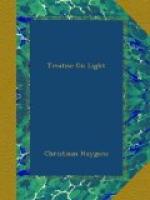6. In all other transparent bodies that we know there is but one sole and simple refraction; but in this substance there are two different ones. The effect is that objects seen through it, especially such as are placed right against it, appear double; and that a ray of sunlight, falling on one of its surfaces, parts itself into two rays and traverses the Crystal thus.
7. It is again a general law in all other transparent bodies that the ray which falls perpendicularly on their surface passes straight on without suffering refraction, and that an oblique ray is always refracted. But in this Crystal the perpendicular ray suffers refraction, and there are oblique rays which pass through it quite straight.
[Illustration]
8. But in order to explain these phenomena more particularly, let there be, in the first place, a piece ABFE of the same Crystal, and let the obtuse angle ACB, one of the three which constitute the equilateral solid angle C, be divided into two equal parts by the straight line CG, and let it be conceived that the Crystal is intersected by a plane which passes through this line and through the side cf, which plane will necessarily be perpendicular to the surface ab; and its section in the Crystal will form a parallelogram GCFH. We will call this section the principal section of the Crystal.
9. Now if one covers the surface ab, leaving there only a small aperture at the point K, situated in the straight line CG, and if one exposes it to the sun, so that his rays face it perpendicularly above, then the ray ik will divide itself at the point K into two, one of which will continue to go on straight by Kl, and the other will separate itself along the straight line km, which is in the plane GCFH, and which makes with Kl an angle of about 6 degrees 40 minutes, tending from the side of the solid angle C; and on emerging from the other side of the Crystal it will turn again parallel to JK, along MZ. And as, in this extraordinary refraction, the point M is seen by the refracted ray MKI, which I consider as going to the eye at I, it necessarily follows that the point L, by virtue of the same refraction, will be seen by the refracted ray LRI, so that LR will be parallel to MK if the distance from the eye KI is supposed very great. The point L appears then as being in the straight line IRS; but the same point appears also, by ordinary refraction, to be in the straight line ik, hence it is necessarily judged to be double. And similarly if L be a small hole in a sheet of paper or other substance which is laid against the Crystal, it will appear when turned towards daylight as if there were two holes, which will seem the wider apart from one another the greater the thickness of the Crystal.




